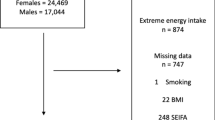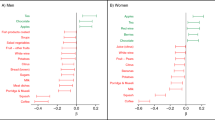Abstract
Objective: We examined the relation between intake of natural dietary plant sterols and serum lipid concentrations in a free-living population.
Design, setting and participants: Cross-sectional population-based study of 22 256 men and women aged 39–79 y resident in Norfolk, UK, participating in the European Prospective Investigation into Cancer (EPIC-Norfolk).
Main exposure and outcome measures: Plant sterol intake from foods and concentrations of blood lipids.
Results: Mean concentrations of total cholesterol and low-density lipoprotein cholesterol, adjusted for age, body mass index and total energy intake, decreased with increasing plant sterol intake in men and women. Mean total serum cholesterol concentration for men in the highest fifth of plant sterol intake (mean intake 463 mg daily) was 0.25 mmol/l lower and for low-density lipoprotein cholesterol 0.14 mmol/l lower than those in the lowest fifth of plant sterol consumption (mean intake 178 mg daily); the corresponding figures in women were 0.15 and 0.13 mmol/l. After adjusting for saturated fat and fibre intakes, the results for total cholesterol and low-density lipoprotein cholesterol were similar, although the strength of the association was slightly reduced.
Conclusions: In a free-living population, a high intake of plant sterols is inversely associated with lower concentrations of total and low-density lipoprotein serum cholesterol. The plant sterol content of foods may partly explain diet-related effects on serum cholesterol concentration.
This is a preview of subscription content, access via your institution
Access options
Subscribe to this journal
Receive 12 print issues and online access
$259.00 per year
only $21.58 per issue
Buy this article
- Purchase on Springer Link
- Instant access to full article PDF
Prices may be subject to local taxes which are calculated during checkout
Similar content being viewed by others
References
Andersson H (1996): Diet and cholesterol metabolism in the gut- implications for coronary heart disease and large bowel cancer. Scand. J. Nutr. 40, 11–15.
Bingham SA, Welch AA, McTaggart A, Mulligan AA, Runswick SA, Luben R, Oakes S, Khaw KT, Wareham N & Day NE (2001): Nutritional methods in the European Prospective Investigation of Cancer in Norfolk. Publ. Health Nutr. 4, 847–858.
Brown L, Rosner B, Willett WW & Sacks FM (1999): Cholesterol-lowering effects of dietary fiber: a meta-analysis. Am. J. Clin. Nutr. 69, 30–42.
Clarke R, Frost C, Collins R, Appleby P & Peto R (1997): Dietary lipids and blood cholesterol: quantitative meta-analysis of metabolic ward studies. BMJ 314, 112–117.
Day N, Oakes S, Luben R, Khaw KT, Bingham S, Welch A & Wareham N (1999): EPIC-Norfolk: study design and characteristics of the cohort. European Prospective Investigation of Cancer. Br. J. Cancer 80 (Suppl 1), 95–103.
Ellegard L, Bosaeus I & Andersson H (2000): Will recommended changes in fat and fibre intake affect cholesterol absorption and sterol excretion? An ileostomy study. Eur. J. Clin. Nutr. 54, 306–313.
Friedewald WT, Levy RI & Fredrickson DS (1972): Estimation of the concentration of low-density lipoprotein cholesterol in plasma, without the use of the preparative ultracentrifuge. Clin. Chem. 18, 499–502.
Gould AL, Rossouw JE, Santanello NC, Heyse JF & Furberg CD (1995): Cholesterol reduction yields clinical benefit. A new look at old data. Circulation 91, 2274–2282.
Grundy SM (1983): Absorption and metabolism of dietary cholesterol. Ann. Rev. Nutr. 3, 71–96.
Jones PJ & Raeini-Sarjaz M (2001): Plant sterols and their derivatives: the current spread of results. Nutr. Rev. 59 (Part 1), 21–24.
Jones PJ, MacDougall DE, Ntanios F & Vanstone CA (1997): Dietary phytosterols as cholesterol-lowering agents in humans. Can. J. Physiol. Pharmacol. 75, 217–227.
Jonker D, van der Hoek GD, Glatz JFC, Homan C, Posthumus MA & Katan MB (1985): Combined determination of free esterified and glycosylated plant sterols in foods. Nutr. Rep. Int. 32, 943–951.
Katan MB, Grundy SM, Jones P, Law M, Miettinen T & Paoletti R (2003): Efficacy and safety of plant stanols and sterols in the management of blood cholesterol levels. Mayo Clin. Proc. 78, 965–978.
Law M (2000): Plant sterol and stanol margarines and health. BMJ 320, 861–864.
Law MR & Wald NJ (1994): An ecological study of serum cholesterol and ischaemic heart disease between 1950 and 1990. Eur. J. Clin. Nutr. 48, 305–325.
Law MR, Wald NJ & Thompson SG (1994): By how much and how quickly does reduction in serum cholesterol concentration lower risk of ischaemic heart disease? BMJ 308, 367–372.
Moghadasian MH & Frohlich JJ (1999): Effects of dietary phytosterols on cholesterol metabolism and atherosclerosis: clinical and experimental evidence. Am. J. Med. 107, 588–594.
Morton GM, Lee SM, Buss DH & Lawrance P (1995): Intakes and major dietary sources of cholesterol and phytosterols in the British diet. J. Hum. Nutr. Dietet. 8, 429–440.
Norm L, Johnsson M, Andersson H, van Gameren Y & Dutta P (1999): Plant sterols in vegetables and fruits commonly consumed in Sweden. Eur. J. Nutr. 38, 84–89.
Norm AL, Brants HA, Voorrips LE, Andersson HA, van den Brandt PA & Goldbohm RA (2001): Plant sterol intakes and colorectal cancer risk in the Netherlands Cohort Study on Diet and Cancer. Am. J. Clin. Nutr. 74, 141–148.
Normén L, Bryngelsson S, Johnsson M, Evheden P, Ellegård L, Brants H, Andersson H & Dutta P (2002): The phytosterol content of some cereal foods commonly consumed in Sweden and in the Netherlands. J. Food Composition Anal. 15, 693–770.
Tang JL, Armitage JM, Lancaster T, Silagy CA, Fowler GH & Neil HA (1998): Systematic review of dietary intervention trials to lower blood total cholesterol in free-living subjects. BMJ 316, 1213–1220.
Wilson MD & Rudel LL (1994): Review of cholesterol absorption with emphasis on dietary and biliary cholesterol. J. Lipid Res. 35, 943–955.
Acknowledgements
We thank the participants and general practitioners who took part in EPIC-Norfolk. We also thank Mitra Ravand for technical assistance in the plant sterol analyses. EPIC-Norfolk is supported by programme grants from the Cancer Research Campaign and Medical Research Council with additional support from the Stroke Association, British Heart Foundation, Food Standards Agency, Department of Health and Wellcome Trust. The phytosterol analyses were supported by a grant from the Swedish government under the LUA agreement and the Swedish Cancer Foundation. There are no competing interests.
Author information
Authors and Affiliations
Contributions
Guarantor: K-T Shaw.
Contributors: K-TK and SB are principal investigators in the EPIC-Norfolk population study. AW and SB are responsible for the nutritional analyses. SA developed the phytosterol nutrient databases with HA and LE. AM prepared the phytosterol data set in the EPIC cohort. JS conducted the statistical analyses with assistance from SA and K-TK. SA wrote the paper with contributions from coauthors.
Corresponding author
Rights and permissions
About this article
Cite this article
Andersson, S., Skinner, J., Ellegård, L. et al. Intake of dietary plant sterols is inversely related to serum cholesterol concentration in men and women in the EPIC Norfolk population: a cross-sectional study. Eur J Clin Nutr 58, 1378–1385 (2004). https://doi.org/10.1038/sj.ejcn.1601980
Received:
Revised:
Accepted:
Published:
Issue Date:
DOI: https://doi.org/10.1038/sj.ejcn.1601980
Keywords
This article is cited by
-
The effects of feeding and starvation on antioxidant defence, fatty acid composition and lipid peroxidation in reared Oncorhynchus mykiss fry
Scientific Reports (2021)
-
Quality parameters, chemical compositions and antioxidant activities of Calabrian (Italy) monovarietal extra virgin olive oils from autochthonous (Ottobratica) and allochthonous (Coratina, Leccino, and Nocellara Del Belice) varieties
Journal of Food Measurement and Characterization (2021)
-
Phytosterol containing diet increases plasma and whole body concentration of phytosterols in apoE-KO but not in LDLR-KO mice
Journal of Bioenergetics and Biomembranes (2019)
-
Associations of dietary phytosterols with blood lipid profiles and prevalence of obesity in Chinese adults, a cross-sectional study
Lipids in Health and Disease (2018)
-
Cholesterol-Lowering Nutraceuticals Affecting Vascular Function and Cardiovascular Disease Risk
Current Cardiology Reports (2018)



